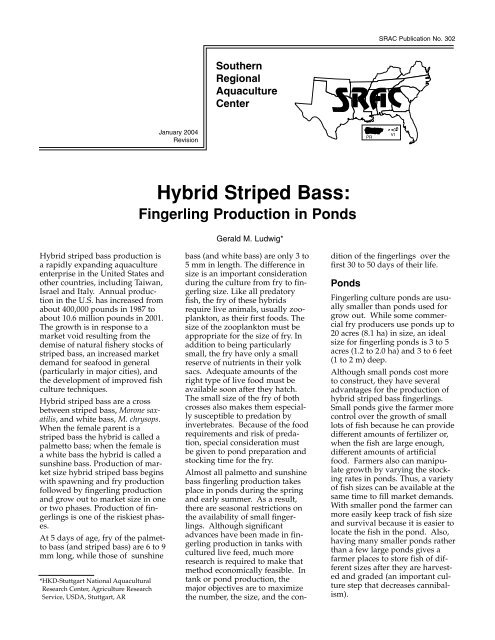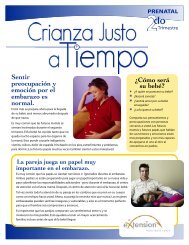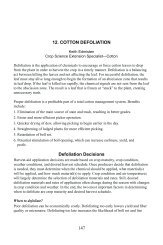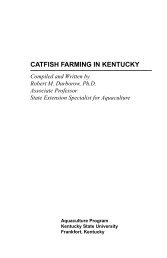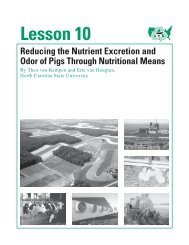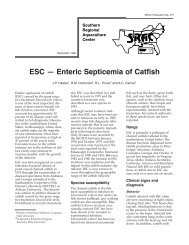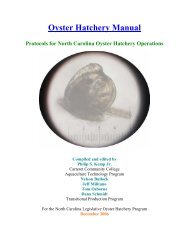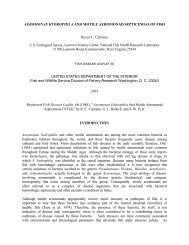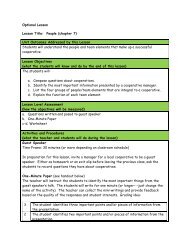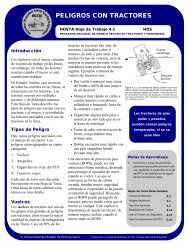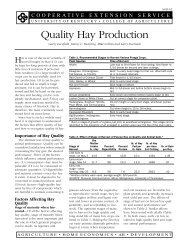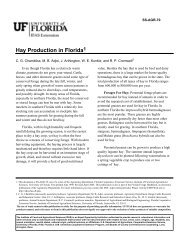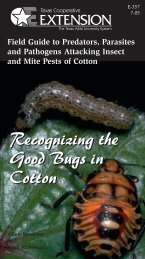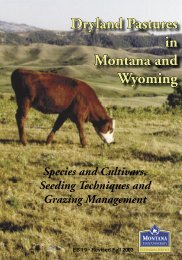Hybrid Striped Bass: - SRAC Fact Sheets
Hybrid Striped Bass: - SRAC Fact Sheets
Hybrid Striped Bass: - SRAC Fact Sheets
You also want an ePaper? Increase the reach of your titles
YUMPU automatically turns print PDFs into web optimized ePapers that Google loves.
<strong>SRAC</strong> Publication No. 302<br />
January 2004<br />
Revision<br />
PR<br />
VI<br />
<strong>Hybrid</strong> <strong>Striped</strong> <strong>Bass</strong>:<br />
Fingerling Production in Ponds<br />
Gerald M. Ludwig*<br />
<strong>Hybrid</strong> striped bass production is<br />
a rapidly expanding aquaculture<br />
enterprise in the United States and<br />
other countries, including Taiwan,<br />
Israel and Italy. Annual production<br />
in the U.S. has increased from<br />
about 400,000 pounds in 1987 to<br />
about 10.6 million pounds in 2001.<br />
The growth is in response to a<br />
market void resulting from the<br />
demise of natural fishery stocks of<br />
striped bass, an increased market<br />
demand for seafood in general<br />
(particularly in major cities), and<br />
the development of improved fish<br />
culture techniques.<br />
<strong>Hybrid</strong> striped bass are a cross<br />
between striped bass, Morone saxatilis,<br />
and white bass, M. chrysops.<br />
When the female parent is a<br />
striped bass the hybrid is called a<br />
palmetto bass; when the female is<br />
a white bass the hybrid is called a<br />
sunshine bass. Production of market<br />
size hybrid striped bass begins<br />
with spawning and fry production<br />
followed by fingerling production<br />
and grow out to market size in one<br />
or two phases. Production of fingerlings<br />
is one of the riskiest phases.<br />
At 5 days of age, fry of the palmetto<br />
bass (and striped bass) are 6 to 9<br />
mm long, while those of sunshine<br />
*HKD-Stuttgart National Aquacultural<br />
Research Center, Agriculture Research<br />
Service, USDA, Stuttgart, AR<br />
bass (and white bass) are only 3 to<br />
5 mm in length. The difference in<br />
size is an important consideration<br />
during the culture from fry to fingerling<br />
size. Like all predatory<br />
fish, the fry of these hybrids<br />
require live animals, usually zooplankton,<br />
as their first foods. The<br />
size of the zooplankton must be<br />
appropriate for the size of fry. In<br />
addition to being particularly<br />
small, the fry have only a small<br />
reserve of nutrients in their yolk<br />
sacs. Adequate amounts of the<br />
right type of live food must be<br />
available soon after they hatch.<br />
The small size of the fry of both<br />
crosses also makes them especially<br />
susceptible to predation by<br />
invertebrates. Because of the food<br />
requirements and risk of predation,<br />
special consideration must<br />
be given to pond preparation and<br />
stocking time for the fry.<br />
Almost all palmetto and sunshine<br />
bass fingerling production takes<br />
place in ponds during the spring<br />
and early summer. As a result,<br />
there are seasonal restrictions on<br />
the availability of small fingerlings.<br />
Although significant<br />
advances have been made in fingerling<br />
production in tanks with<br />
cultured live feed, much more<br />
research is required to make that<br />
method economically feasible. In<br />
tank or pond production, the<br />
major objectives are to maximize<br />
the number, the size, and the condition<br />
of the fingerlings over the<br />
first 30 to 50 days of their life.<br />
Ponds<br />
Fingerling culture ponds are usually<br />
smaller than ponds used for<br />
grow out. While some commercial<br />
fry producers use ponds up to<br />
20 acres (8.1 ha) in size, an ideal<br />
size for fingerling ponds is 3 to 5<br />
acres (1.2 to 2.0 ha) and 3 to 6 feet<br />
(1 to 2 m) deep.<br />
Although small ponds cost more<br />
to construct, they have several<br />
advantages for the production of<br />
hybrid striped bass fingerlings.<br />
Small ponds give the farmer more<br />
control over the growth of small<br />
lots of fish because he can provide<br />
different amounts of fertilizer or,<br />
when the fish are large enough,<br />
different amounts of artificial<br />
food. Farmers also can manipulate<br />
growth by varying the stocking<br />
rates in ponds. Thus, a variety<br />
of fish sizes can be available at the<br />
same time to fill market demands.<br />
With smaller pond the farmer can<br />
more easily keep track of fish size<br />
and survival because it is easier to<br />
locate the fish in the pond. Also,<br />
having many smaller ponds rather<br />
than a few large ponds gives a<br />
farmer places to store fish of different<br />
sizes after they are harvested<br />
and graded (an important culture<br />
step that decreases cannibalism).
Figure 1. Eight-day-old sunshine bass fry with gut filled with rotifers.<br />
There are many things that can go<br />
wrong in ponds during the culture<br />
of hybrid striped bass fingerlings,<br />
including sudden pH<br />
changes, excessive ammonia,<br />
rapid weather changes, and predation<br />
by large zooplankton or<br />
insects. Culturing fish in many<br />
small ponds rather than in a few<br />
large ponds helps ensure that a<br />
sufficient number of fingerlings<br />
get to market.<br />
Natural food<br />
<strong>Hybrid</strong> striped bass fry require<br />
live food, so fry ponds are managed<br />
to provide a maximum<br />
amount of zooplankton of the<br />
right size for the fry to consume.<br />
Previous recommendations for<br />
palmetto bass stated that fry<br />
should be stocked when large<br />
crustacean zooplankton such as<br />
copepods and cladocerans are<br />
numerous. It takes 2 or more<br />
weeks after ponds are filled and<br />
fertilized for that to happen during<br />
the striped bass and white<br />
bass spawning seasons. However,<br />
crustacean zooplankton are too<br />
large for the smaller sunshine bass<br />
to consume and may even prey on<br />
fry, so the ponds should be managed<br />
to contain large numbers of<br />
smaller rotifers when the fry are<br />
stocked. Masses of rotifers usually<br />
appear just before the larger<br />
zooplankton emerge. In recent<br />
research with striped bass fry (the<br />
same size as palmetto bass fry),<br />
the highest fingerling survival<br />
rates occurred when the fry were<br />
stocked before crustacean zooplankton<br />
became numerous.<br />
Because of that finding, the recommendations<br />
that follow apply<br />
to culture of both types of hybrids<br />
and striped bass.<br />
Most of the hybrid striped bass<br />
now cultured are sunshine bass<br />
because female white bass produce<br />
viable eggs in captivity<br />
while female striped bass often do<br />
not, particularly when they are<br />
held in ponds and subjected to<br />
high water temperatures.<br />
Accordingly, when female striped<br />
bass are used they must be captured<br />
from public waters just<br />
before spawning every year. Male<br />
striped bass mature at the same<br />
age as female white bass and produce<br />
viable sperm when raised in<br />
captivity. Female white bass are<br />
smaller, easier to handle, and<br />
become mature at least a year earlier<br />
than female striped bass. This<br />
publication will focus on proven<br />
methods for culturing sunshine<br />
bass. These methods also produce<br />
higher survival rates of striped<br />
bass and palmetto bass than previously<br />
recommended methods.<br />
Farmers who waited several<br />
weeks after filling their ponds to<br />
stock sunshine bass usually had<br />
little success. The average survival<br />
rate during the 1980s was<br />
about 10 percent. Farmers soon<br />
learned that they could get good<br />
survival when they stocked 4- to<br />
5-day-old fry in ponds that had<br />
been filled and fertilized for about<br />
5 days. The “Five Day Method”<br />
worked best during the peak of<br />
the white bass spawning season<br />
when water temperatures are 63<br />
to 73 °F (17 to 23 °C). However,<br />
survival rates dropped off rapidly<br />
when fry were stocked earlier or<br />
later during the spring.<br />
The reason the Five Day Method<br />
worked was that the farmers were<br />
stocking their fry at the proper<br />
stage of zooplankton succession<br />
in the ponds. Succession is the<br />
term describing the changes that<br />
occur in plant and animal communities<br />
over time. These changes<br />
are fairly predictable if conditions<br />
remain consistent. However, conditions<br />
such as temperature, rainfall<br />
and the amount of sunlight<br />
vary from year to year or during<br />
the spawning season and these<br />
changes affect the timing of<br />
events in the plankton community.<br />
Pond succession most suitable for<br />
sunshine bass culture follows the<br />
sequence shown in Figure 2. In<br />
mid-spring in the southern U.S.,<br />
when most sunshine bass fingerlings<br />
are produced, ponds that are<br />
filled with well water and fertilized<br />
soon develop a light green<br />
color. A phytoplankton bloom,<br />
the very rapid increase in concentration<br />
of microscopic algae, causes<br />
that color. Simultaneously,<br />
blooms of bacteria and protozoans<br />
usually occur. Within a few days,<br />
rotifer populations begin to<br />
increase rapidly. When that happens<br />
the green color fades as the<br />
rotifers consume the algae and the<br />
water often turns to tan or brown.<br />
As this occurs, copepod and<br />
cladoceran eggs are hatching. As<br />
these crustacean populations<br />
grow they out-compete the<br />
rotifers or prey upon them and
Figure 2. A typical sequence of events in the zooplankton community when ponds<br />
are filled and fertilized during spring. Soon after the ponds are filled rotifer populations<br />
rapidly increase, but then very rapidly decrease in abundance. The rotifers<br />
are replaced by smaller numbers of the larger copepod nauplii and then the even<br />
larger adult copepods. Along with the copepods, large cladocerans also make their<br />
appearance. Data for this graph was obtained from three ponds that contained sunshine<br />
bass fry that were preying on the zooplankton. Survival in the ponds averaged<br />
59 percent.<br />
rotifer numbers plummet. High<br />
concentrations of copepod nauplii,<br />
copepod adults and then<br />
cladocerans appear in succession<br />
and then decline as populations of<br />
larger rotifers and insects make<br />
their appearance. Sunlight and<br />
fertilizer fuel this whole sequence<br />
of events and the rate of succession<br />
is regulated by water temperature.<br />
One highly important key<br />
to successful fingerling culture is<br />
to stock the fry at the beginning of<br />
the rotifer population explosion.<br />
<strong>Hybrid</strong> bass thrive on these<br />
organisms and will grow large<br />
enough to consume the larger<br />
zooplankton when they appear.<br />
By that time the fry also should be<br />
able to escape predation by the<br />
cyclopoid copepods. The fry that<br />
are stocked should not be more<br />
than 5 days old if possible. Older<br />
fry may not have enough energy<br />
reserves in their yolk sacs to<br />
enable them to consume zooplankton.<br />
(See <strong>SRAC</strong> Publication<br />
No. 700)<br />
It is important to be able to predict<br />
when the rotifer population is<br />
starting to rapidly increase. Water<br />
temperature is the main environmental<br />
variable that controls when<br />
this will happen. Day length and<br />
water fertility also influence the<br />
timing of peak populations. Fry<br />
should be stocked several days<br />
before the peak rotifer population<br />
is reached. During colder weather<br />
the time between stocking and the<br />
peak should be increased; the<br />
opposite is true during very warm<br />
weather. Table 1 shows the relationship<br />
between the mean morning<br />
water temperatures and the<br />
number of days it will take to<br />
reach the peak of the rotifer<br />
bloom. This information was<br />
determined by measuring water<br />
temperature and collecting zooplankton<br />
daily after ponds were<br />
filled and then relating the two<br />
values mathematically. This relationship<br />
is expressed by the equation:<br />
D = 29.7 - 0.95 (C)<br />
or,<br />
D = 46.6 - 0.53 (F)<br />
where D equals the number of<br />
days between when ponds are<br />
filled and the peak rotifer concentration<br />
occurs, and C or F equals<br />
the average of morning water<br />
temperatures in centigrade or<br />
Fahrenheit between the time<br />
ponds are filled and the rotifer<br />
peak occurs.<br />
Farmers should keep records of<br />
water temperatures in order to<br />
predict when to stock their ponds<br />
during different times that fry are<br />
available. Although it is impossible<br />
to know what future water<br />
temperatures will be, the equations<br />
can be used to estimate the<br />
time it will take to reach a rotifer<br />
peak. For instance, if your records<br />
show that on April 15 the average<br />
water temperature is 65 °F, then it<br />
will take about 12 days to reach<br />
the rotifer peak. Assuming that<br />
Table 1. The effect of the average water temperature on the time it<br />
takes to reach peak rotifer concentrations in ponds after being filled<br />
with well water and fertilized.<br />
Average daily water temperature<br />
Degrees F Degrees C Days to peak rotifer population<br />
45 7.2 23<br />
50 10.0 20<br />
55 12.8 18<br />
60 15.6 15<br />
65 18.3 12<br />
70 21.1 10<br />
75 23.9 7<br />
80 26.7 4
65 °F occurs at the midpoint of the<br />
time before the peak, then ponds<br />
filled 6 days before the 15 th should<br />
have a rotifer concentration peak<br />
12 days later or on April 21. Fry<br />
that are stocked 7 to 9 days after<br />
the ponds are filled should have<br />
sufficient rotifers to ensure good<br />
survival. As the season progresses<br />
fry should be stocked closer to the<br />
time that ponds are filled. Since<br />
spring weather is highly variable,<br />
these equations are best used for<br />
general planning and, perhaps, to<br />
help understand why fingerling<br />
survival is high or low. For<br />
instance, using the Five Day<br />
Method in early spring places fry<br />
in the pond long before rotifers<br />
are present, while using it at the<br />
end of the season places fry into<br />
ponds were rotifers have been<br />
replaced with copepods that are<br />
too large to eat and that may even<br />
prey on the fry.<br />
The relationship between air temperature<br />
and water temperature is<br />
another way to predict when the<br />
rotifer bloom will peak. Table 2<br />
shows the relationship between<br />
the average daily air temperature<br />
in Stuttgart, Arkansas and the<br />
number of days before the peak in<br />
the rotifer population. That relationship<br />
follows the equation:<br />
D = 27.3 - 0.88 (C)<br />
or,<br />
D= 43.0 - 0.49 (F)<br />
where D equals the number of<br />
days between when ponds are<br />
filled and the peak rotifer concentration<br />
occurs, and C or F equals<br />
the average of morning air temperatures<br />
in centigrade or<br />
Fahrenheit between the time<br />
ponds are filled and the rotifer<br />
peak occurs.<br />
There may be some minor variations<br />
in this relationship because<br />
of differences in pond depth,<br />
wind speeds, humidity and other<br />
factors, but the equation can be<br />
used to predict when rotifers will<br />
reach their population peak. The<br />
average daily air temperature can<br />
be obtained from local airports or<br />
from the U.S. Department of<br />
Commerce, National Climatic<br />
Data Center, Federal Building,<br />
Asheville, North Carolina 28801.<br />
Their publication, “Local<br />
Climatological Data—Unedited,”<br />
is also available from the National<br />
Climatological Data Center at<br />
www.ncdc.noaa.gov.<br />
Pond preparation<br />
Fingerlings survive best when<br />
well water is used to fill ponds.<br />
With well water, rotifer concentrations<br />
are easier to predict. Surface<br />
water should not be used because<br />
it usually contains zooplankton<br />
too large for sunshine bass to consume<br />
and that may prey on fry.<br />
Pond alkalinity should be above<br />
50 mg/L to help stabilize pH and<br />
facilitate the uptake of nutrients<br />
by phytoplankton. If the water<br />
has less than 20 mg/L total alka-<br />
Table 2. Normal average daily air temperatures at Stuttgart, AR and<br />
the number of days it takes to reach a peak in the rotifer population<br />
after sunshine bass culture ponds are filled with well water and fertilized.<br />
Date Normal average daily Days to peak rotifer<br />
air temperature<br />
population<br />
Degrees F Degrees C<br />
March 1 48 9 19<br />
March 15 52 11 18<br />
April 1 59 15 14<br />
April 15 63 17 12<br />
May 1 66 19 11<br />
May 15 70 21 9<br />
June 1 73 23 7<br />
linity, it should be limed. Waters<br />
with 20 to 50 mg/L alkalinity<br />
would benefit from the application<br />
of lime. Waters with more<br />
than 50 mg/L usually do not<br />
require lime applications (See<br />
<strong>SRAC</strong> Publication No. 469.)<br />
Although the exact relationship<br />
has not been determined, fingerling<br />
survival is generally better in<br />
ponds with alkalinities above 100<br />
mg/L.<br />
The greater the number of zooplankton<br />
of appropriate size, the<br />
greater the chances fry will survive<br />
and grow, as long as good<br />
water quality is maintained.<br />
Ponds must be fertilized to provide<br />
nutrients for the formation of<br />
plankton blooms. Applying both<br />
organic and inorganic fertilizers<br />
usually is best.<br />
Organic fertilizers are the basis of<br />
a food pyramid that nourishes<br />
bacteria, protozoans, phytoplankton,<br />
zooplankton and eventually<br />
the fish fry. (Some organic fertilizers,<br />
such as rice bran, are ground<br />
fine enough that they are consumed<br />
by zooplankton.) Phytoplankton<br />
grow on the inorganic<br />
nutrients released when bacteria<br />
decompose the organic fertilizers.<br />
Protozoans and rotifers eat the<br />
bacteria and phytoplankton.<br />
Phytoplankton is also the main<br />
food source for many copepods<br />
and most cladocerans. It takes<br />
time for nutrients from organic<br />
fertilizers to be released, so drastic<br />
changes in zooplankton populations<br />
are less likely to occur than<br />
when only inorganic fertilizers are<br />
used.<br />
Inorganic fertilizers make their<br />
nutrients available without bacteria.<br />
They release most of their<br />
nutrients to the water immediately,<br />
although some slow-release fertilizers<br />
are available. Phytoplankton<br />
blooms can be developed very<br />
rapidly when inorganics are used,<br />
but the bloom may “crash” quickly<br />
as the nutrients are depleted.<br />
The diversity of plankton in a<br />
pond is probably greater and the<br />
total community more stable<br />
when both organic and inorganic<br />
fertilizers are used. The diverse<br />
community utilizes nutrients<br />
quickly. Nutrients may also be
trapped in the pond bottom. As a<br />
result, ponds should be fertilized<br />
often in small doses rather than in<br />
a few larger doses. This procedure<br />
also helps prevent low dissolved<br />
oxygen, rapid pH changes<br />
and the increased chance of dangerously<br />
high un-ionized ammonia<br />
levels.<br />
The following fertilization schedule<br />
has produced high survival<br />
and good growth in sunshine<br />
bass fingerlings. As ponds are<br />
being filled, add 125 pounds per<br />
acre (140 kg per ha) of rice bran<br />
or cottonseed meal and 2 gallons<br />
(7.5 L) of a 10-30-0 NPK liquid<br />
fertilizer. Add similar doses of<br />
organic and liquid fertilizer 3<br />
days later. During each of the second<br />
and third weeks add two<br />
doses of 25 pounds per acre (28<br />
kb per ha) of the organic fertilizer<br />
and two treatments of 1 gallon of<br />
liquid fertilizer. For the next 2<br />
weeks reduce the application rate<br />
of organic fertilizer and liquid fertilizer<br />
by half. During subsequent<br />
weeks add fertilizer when vertical<br />
visibility, as measured by Secchi<br />
disc readings, is more than 18<br />
inches (0.5 m). When using this<br />
schedule there is sometimes a<br />
spike in the pH that causes high<br />
un-ionized ammonia levels. If this<br />
happens, the inorganic fertilizer<br />
should be reduced or eliminated<br />
during the first week. This fertilization<br />
schedule is a recommended<br />
starting point that should be<br />
modified to suit the characteristics<br />
of each farm. Very good survival<br />
has been achieved with less<br />
fertilizer and when only inorganic<br />
or organic fertilizers were used.<br />
nate the filling and fertilizing of<br />
ponds with the shipment of fry<br />
from the dealer. Pond water<br />
chemistry must also be close to<br />
that of the water in which the fry<br />
are shipped. Great care must be<br />
taken to acclimate the fish to the<br />
pond conditions and it must be<br />
done at the right speed to avoid<br />
problems with metabolic wastes<br />
that accumulate in the shipping<br />
bags. Stocking rates vary from<br />
100,000 to 200,000 fry per acre<br />
(247,100 to 494,200 per ha). Lower<br />
stocking rates may result in larger<br />
fingerlings at harvest but may<br />
also result in greater variation in<br />
sizes and, as a result, more cannibalism.<br />
Higher stocking rates produce<br />
smaller fingerlings and often<br />
cause zooplankton stocks to be<br />
depleted rapidly. The number of<br />
fry received is usually estimated<br />
by the fry dealer. Often he will<br />
make a volumetric estimate of the<br />
number of viable eggs he has<br />
placed in hatching jars. The culturist<br />
also can estimate the number<br />
of fry volumetrically. The volume<br />
of water the fry are shipped<br />
in is determined and then mixed<br />
to distribute the fry evenly. Then<br />
small samples of known volume<br />
are taken from the water and the<br />
number of fry they contain counted<br />
and a number per ounce (or<br />
other unit) determined. That number<br />
is multiplied by the total<br />
ounces of water the fry were<br />
shipped in. This must be done<br />
quickly once the bag is opened<br />
and oxygen levels decrease.<br />
<strong>Hybrid</strong> striped bass fry have better<br />
survival rates when they are<br />
stocked under low light conditions,<br />
as in early evening.<br />
However, sometimes a rapidly<br />
developing phytoplankton bloom<br />
will use much of the dissolved<br />
carbon dioxide in a pond, and if<br />
the pond does not have adequate<br />
buffering capacity the pH may<br />
rise to an intolerable level (above<br />
9 is usually harmful). If ammonia<br />
levels are also high, the elevated<br />
pH will increase the concentration<br />
of the toxic un-ionized fraction<br />
and that condition can rapidly<br />
become lethal to the fry, too. If pH<br />
is spiking during the late afternoon<br />
it is best to wait until early<br />
Stocking fry<br />
Several studies indicate that what<br />
happens to fry at the time of<br />
stocking probably has the greatest<br />
influence on survival of fingerlings<br />
at harvest. Only healthy fry<br />
of the proper age that have been<br />
cared for during and after shipment<br />
should be stocked. Ponds<br />
must be at the right stage of zooplankton<br />
development; farmers<br />
must estimate the time required<br />
for rotifers to reach their peak<br />
concentrations and then coordimorning<br />
to stock the fry.<br />
Respiration and the absence of<br />
photosynthesis during the night<br />
usually causes pH to become<br />
more neutral by dawn.<br />
When fry are brought to the farm<br />
in bags, the bags should be floated<br />
unopened in the ponds until the<br />
water temperature in the bags is<br />
the same as that of the ponds. If<br />
the bags, are opened for too long<br />
carbon dioxide that has accumulated<br />
will escape and pH will<br />
increase. When that happens<br />
ammonia that has accumulated<br />
may become un-ionized and harm<br />
the fry. When the water temperature<br />
is equalized, open the bag<br />
and roll the sides down to form a<br />
collar that allows the bag to float.<br />
A bucket without a bottom in it<br />
can be used to hold the bags. Pour<br />
a small amount of pond water<br />
(about a pint) into the open bag.<br />
About 5 minutes later, pour twice<br />
as much water into the bag. After<br />
each succeeding 5 minutes double<br />
the amount of water going into<br />
the bag. After 20 to 30 minutes<br />
pour the entire bag into the pond.<br />
This procedure allows the fish to<br />
gradually become adjusted to the<br />
temperature and water chemistry<br />
in the pond without being injured<br />
by rising un-ionized ammonia<br />
concentrations in the bag.<br />
Fry survival in ponds is difficult<br />
to determine because they are<br />
small. About a week after being<br />
stocked, fry may be attracted to<br />
lights on dark nights and then<br />
caught with a zooplankton net.<br />
After 2 weeks in the ponds the<br />
number of fry captured with a<br />
constant number of net sweeps in<br />
similar ponds is often proportional<br />
to the survival rates in those<br />
ponds. Survival in ponds may be<br />
very roughly estimated at 3 to 4<br />
weeks by standing still and closely<br />
observing the pond edges.<br />
Schools of small fingerlings may<br />
be seen streaming along.<br />
Once the fish are in the pond they<br />
must have adequate amounts of<br />
zooplankton to eat until they can<br />
eat prepared feed. When survival<br />
is good the fish may consume<br />
zooplankton faster than it can be<br />
naturally produced. This can lead
to cannibalism. To help prevent it,<br />
provide artificial feed to supplement<br />
the zooplankton.<br />
Supplementation also helps to<br />
wean the fingerlings so that they<br />
are ready for tank culture or culture<br />
in ponds with prepared<br />
feeds. Fry can survive on finely<br />
ground high-protein feeds after<br />
they are 26 days old or after<br />
about 3 weeks in the pond.<br />
Before they reach that stage, food<br />
such as a 45% or greater protein<br />
starter meal should be cast on the<br />
ponds one to three times a day at<br />
the rate of 2 to 10 pounds (0.9 to<br />
4.5 kg) per acre per day. Mashes<br />
are fine enough that they may<br />
also be consumed by some zooplankton<br />
species. Fingerlings eating<br />
this zooplankton may become<br />
accustomed to prepared feeds<br />
more rapidly than when larger<br />
food is offered first. The size of<br />
the feed should be increased to a<br />
number one crumble when the<br />
fry are about 4 weeks old. At 4 to<br />
5 weeks of age the fish should<br />
start feeding at the surface. After<br />
a few days of surface feeding the<br />
fingerlings’ feeding behavior<br />
makes it possible to adjust the<br />
feeding rate. Feed should be<br />
applied to the pond until obvious<br />
feeding stops. A few minutes later<br />
check for uneaten feed and adjust<br />
the amount given accordingly.<br />
Harvesting fingerlings<br />
Harvesting is another critical time<br />
in the culture of sunshine and<br />
palmetto bass. These fish, particularly<br />
the palmetto bass, are highly<br />
susceptible to shock brought<br />
on by physical or chemical stress.<br />
Highly stressed fingerlings often<br />
have tetanized muscles that cause<br />
the fish to curl. Stress during harvesting<br />
may kill fingerlings or<br />
make them highly susceptible to<br />
future disease. Prevent stress by<br />
handling fish carefully, maintaining<br />
high levels of dissolved oxygen,<br />
preventing chemical or temperature<br />
shocks, and using salt.<br />
After 30 to 45 days the fingerlings<br />
should be harvested and graded.<br />
If this is not done cannibalism<br />
may cause significant losses.<br />
Harvesting is done with a 1 /4-inch<br />
mesh seine or by draining ponds<br />
that have catch basins. When<br />
seines are pulled to the bank it is<br />
important to cast salt on the area<br />
where fish are concentrated and<br />
to ensure that high levels of dissolved<br />
oxygen are maintained. A<br />
water pump or compressed air<br />
aeration can provide dissolved<br />
oxygen and keep the water clean.<br />
Do not let fish become crowded in<br />
the seine.<br />
Survival can be estimated during<br />
harvesting. One method is to add<br />
fingerlings to buckets that are<br />
one-third to one-half full of water<br />
and have been weighed on a<br />
scale. Weigh the buckets again<br />
with the fish and add up the total<br />
weight of fish harvested. Then<br />
count out a small number of fish<br />
and weigh them to get the average<br />
weight per fish. Divide that<br />
weight into the total weight harvested<br />
to get the total number of<br />
fish harvested. That number<br />
divided by the number of fry<br />
stocked gives the survival rate.<br />
Experienced sunshine bass farmers<br />
average 25 to 40 percent survival.<br />
Fingerlings should be removed<br />
from the seine without delay,<br />
using 1 /4-inch, uncoated nets, then<br />
placed in buckets of water and<br />
loaded into a hauling truck that<br />
contains salted water (up to 10<br />
grams per liter). Use salt that does<br />
not contain anti-caking compounds<br />
that may be toxic to the<br />
fish. Dissolved oxygen levels<br />
should be maintained at 5 mg/L<br />
or higher. If possible, use water<br />
from the pond being harvested.<br />
Upon reaching the holding shed,<br />
make sure the fish are not<br />
shocked by rapid changes in<br />
water temperature. Temper the<br />
fish by having water similar to<br />
that in the holding vats pass into<br />
the tanks on the hauling truck.<br />
Allow about a half hour for each<br />
4 °F (2 °C) difference in water<br />
temperature.<br />
Transfer the fingerlings to a tank<br />
where they can be graded the<br />
next day. The largest and the<br />
smallest fish should be separated<br />
from the rest. The largest fish are<br />
probably cannibalizing smaller<br />
fish, and the smallest fish are<br />
probably not acclimating well to<br />
prepared feed. The middle-sized<br />
group may be further divided<br />
into groups for shipment to customers,<br />
placement in grow-out<br />
ponds or tanks, or later shipment<br />
to grow-out facilities. More than<br />
one grading, particularly for fish<br />
held in tanks, is often necessary.<br />
Before being restocked the fingerlings<br />
should be further trained to<br />
eat a prepared diet of at least 45<br />
to 50 percent protein. Determine<br />
the proper size to feed by experimentation,<br />
starting with striped<br />
bass feed or salmon starter in<br />
number 1, 2, 3 or 4 crumble.<br />
Fingerlings that are sold should<br />
be acclimated to cool water and<br />
allowed to purge for at least a day<br />
before being shipped. The shipping<br />
water should be salted (0.5<br />
to 1% or 5 to 10 g/L NaCl 2 , CaCl 2 ,<br />
or sea salt) to reduce the effects of<br />
stress. A commercial anti-ammonia<br />
compound is also added to<br />
the water. If the fish are going to<br />
be shipped by air (and sometimes<br />
by ground) they are placed in a<br />
few gallons of salted water and<br />
into doubled plastic bags that are<br />
inflated with oxygen and then<br />
placed into an insulated shipping<br />
box and sealed. Large shipments<br />
by ground transportation are<br />
loaded into insulated compartments<br />
on a hauling truck that has<br />
a supply of liquid oxygen and an<br />
aeration system. Dissolved oxygen<br />
should be kept above 5<br />
mg/L. The water should be agitated<br />
to prevent buildup of carbon<br />
dioxide. Temperatures should<br />
be kept below 70 °F (21 °C).<br />
It is important to fully coordinate<br />
the timing of harvesting and hauling<br />
operations with customers.
References<br />
Anderson, R.O. 1993. Apparent<br />
problems and potential solutions<br />
for production of fingerling<br />
striped bass, Morone saxatilis.<br />
p. 111-118. In: Strategies<br />
and tactics for management of<br />
fertilized hatchery ponds. Ed.<br />
R.O. Anderson and D. Tave.<br />
Food Products Press.<br />
Binghamton, New York.<br />
Ludwig, G.M. 1993. Effects of<br />
trichlorfon, fenthion, and<br />
diflubenzuron on the zooplankton<br />
community and on<br />
production of reciprocal-cross<br />
hybrid striped bass fry in culture<br />
ponds. Aquaculture<br />
110:301-319.<br />
Ludwig, G.M. 1999. Zooplankton<br />
succession and Larval Fish<br />
Culture in Freshwater Ponds.<br />
Southern Regional<br />
Aquaculture Center<br />
Publication Number 700.<br />
Ludwig, G.M. 2000. Effect of<br />
environmental factors on<br />
development of rotifer and<br />
copepod nauplii populations<br />
in sunshine bass Morone<br />
chrysops X M. saxatilis nursery<br />
pond without fish. Journal of<br />
the World Aquaculture Society.<br />
31:1-13.<br />
Ludwig, G.M., N.M. Stone and C.<br />
Collins. 1998. Fertilization of<br />
Fish Fry Ponds. Southern<br />
Regional Aquaculture Center<br />
Publication Number 469.
<strong>SRAC</strong> fact sheets are reviewed annually by the Publications, Videos and Computer Software Steering<br />
Committee. <strong>Fact</strong> sheets are revised as new knowledge becomes available. <strong>Fact</strong> sheets that have not<br />
been revised are considered to reflect the current state of knowledge.<br />
The work reported in this publication was supported in part by the Southern Regional Aquaculture Center<br />
through Grant No. 2002-38500-11805 from the United States Department of Agriculture, Cooperative State<br />
Research, Education, and Extension Service.


